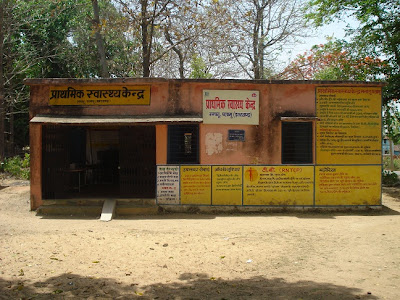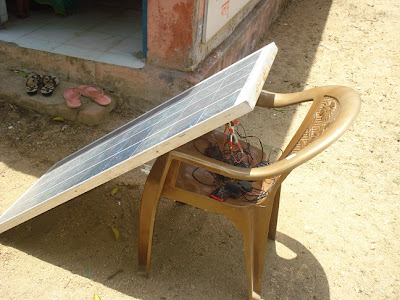As part of our responsibilities of a Tuberculosis Unit catering to a population of about 650,000 (each TU usually caters to 500,000 population), we need to make supervisory visits to the different Primary Health Centres and Microscopy Centres in our area.
It has been quite some time since I had visited the areas after Dr Johnson took over charge of the TU. Over the last week, it has been obvious that Dr Johnson may not be continuing with us and I thought it would be good to accompany the TU staff while they supplied the drugs.
It turned out that there was a new MDRTB (Multi-drug Resistant Tuberculosis) patient in our area - in fact the first one in Palamu district to be started on DOTS Plus anti-tuberculosis treatment regimen. I had to visit him.
Being summer, I was relieved that the air-conditioned Bolero was at my disposal. Along desolate, dry and depressing landscape, I made my way to each of the Primary Health Centres under us. For confidentiality's sake I do not wish to mention the names of any of the places I went to. Of course, there are photographs . . .
The first place of my visit was a Community Health Centre. It operated from a new building since the last time I had visited it. Quite spacious and well planned, it was an administrator's dream. Well, I was told there were 10 doctors posted. About 2-4 of them visited the Outpatient every day. There was no resident doctor although there was a shabby quarters for them at the entrance of the CHC.
From the staff, I came to know that there were about 30-40 deliveries every month. However, there were hardly any facilities to manage complications. This is was the CHC for our target area of around 600,000 population.
The TB facilities were as expected. Lower number of sputum examination rates of chest symptomatics.
We could not meet any of the Medical Officers or other staff as it was too early. But, late enough for the private lab run by the laboratory technician to have opened and started business.
On the way to the next place, a Primary Health Centre, we met AD - supposed to be our first Multidrug Resistant Tuberculosis patient to have been started on DOTS-Plus.
We reached the PHC as the daily business was on full swing. Old buildings doted the compound. I was introduced to the Medical Officer in charge - I was quite surprised the way he was talking. He appeared quite incoherent and confused. I thought that he is old - nearing retirement - some amount of senile dementia setting in . . .
As I came out after meeting the old doctor, one of the staff asked me if I understood anything he spoke. It seems that he was a die hard ganja (local name for cannabis) addict. It was sad . . . The situation about tuberculosis was the same at this PHC too. The best part was a very enthusiastic laboratory technician, RK who kept the numbers coming in a good pace. . .
Then, was a long drive through some badly Naxalite infested areas to our third place. The PHC which caters to a population of around 120,000 did not have any doctors visiting the place for ages.
The staff appeared quite protective about the status of doctors visiting the place. Once more, we had a very enthusiastic laboratory technician who was very pro-active.
 |
| The PHC . . . No takers . . . |
 |
| Indication of better times. The old dilapidated doctor's quarters |
 |
| Poor electricity facilities, necessitating devices like this solar powered mobile phone charger |
The staff appeared quite protective about the status of doctors visiting the place. Once more, we had a very enthusiastic laboratory technician who was very pro-active.
We were quite tired by the time we finished the third place.
In between the next visit, we visited one Catholic mission centre where they were trying for the upliftment of the tribal community. It had been 12 years since the work had started - but it seems that the community was hardly interested in any sort of development or progress. The mission centre was running a school for the local community. Of recent, they have sort of taken an foray into healthcare too - and we had been supporting them technically. A very potential place for virgin public healthcare work to start. . .
By the time, we reached our last PHC, it was late afternoon. The outpatient was over and most of the staff had left. The lab technician was waiting for us to arrive. We were also in a hurry . . .
It was around late evening by the time we reached back to NJH. . .
Lessons learnt at the end of the visit -
1. Rural public healthcare is a neglected area in our country.
2. There is a need for committed healthcare personnel in such places.
3. We're not going to achieve much in terms of vital statistics if there is no drastic improvement of public healthcare facilities.
4. Committed staff such as the two lab technicians we met do not receive any sort of accolades for the service they render to such difficult communities. Which of course prevents others from coming to serve in such areas.
5. There were many more patients like AD all over our communities. The challenge is to reach out and find them.





Sad state of affairs in India. I have worked in primary centres i know how pathetic the situation there is. Terrible indeed
ReplyDeleteSad state of affairs in India. I have worked in primary centres i know how pathetic the situation there is. Terrible indeed
ReplyDelete